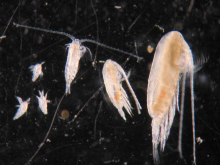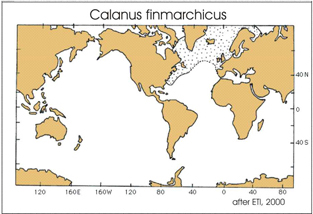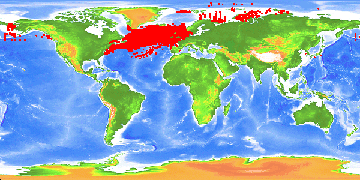|
|
|
| |
Monoculus
finmarchicus (Gunnerus, 1770)
Cetochilus septentrionalis
(Goodsir)
Calanus spitsbergensis
(Kröyer)
Calanus quinqueannulatus
(Kröyer)
Calanus tonsus,
(Brady, 1883)
|
| |
Kingdom Animalia
-- animals, animales, animaux |
| |
Phylum Arthropoda
-- arthropods, artrópodos, arthropodes |
| |
Subphylum Crustacea
Brünnich, 1772 -- crustaceans, crustáceos, crustacés |
| |
Class Maxillopoda
Dahl, 1956 |
| |
Subclass Copepoda
Milne-Edwards, 1840 --copepods, copépodos, copépodes |
| |
Infraclass Neocopepoda
Huys & Boxshall, 1991 |
| |
Superorder Gymnoplea
Giesbrecht, 1882 |
| |
Genus Calanus
Leach, 1816 |
| |
Species Calanus
finmarchicus Gunner, 1765 |
| |
A calanid copepod of the genus Calanus.
In the North Atlantic, C. finmarchicus can be confused
with congeners C. helgolandicus and C. glacialis
which both overlap in size and range with C. finmarchicus.
It has also been mistaken for C. marshallae which
resides in the northern Pacific Ocean. C. finmarchicus
does not occur in the Pacific Ocean. To date, C. finmarchicus
specimens found in the Pacific have been incorrectly identified
C. marshallae. Another species of Calanus overlapping
in range with C. finmarchicus is C. hyperboreus,
a significantly larger species.
Adult C. finmarchicus can be distinguished from C.
helgolandicus, chiefly by:
| 1. |
the less elongated outer
ramus of the left last
leg in the male. |
| 2. |
the
female 5th leg basipod of C. helgolandicus
has a curved interior margin |
| 3. |
the more evenly rounded frontal
part of the female head |
| 4. |
the longer caudal rami |
| 5. |
larger size than C. helgolandicus
(female prosome 1.98-2.80mm, Fleminger & Hulsemann,
1977) |
| 6. |
the pore
signature pattern of integumental organs as described
by Fleminger and Hulsemann (1977). |
7. |
the geographical range of C. helgolandicus
is centered in the eastern N. Atlantic and warmer waters
of the western N. Atlantic |
Adult Calanus finmarchicus can be distinguished
from C. glacialis, and C. marshallae by:
1. |
the less elongated outer ramus of the
left 5th
leg in the male. |
| 2. |
the
female head shape |
| 3. |
the female
5th leg basipod of C. glacialis has a curved
interior margin |
| 4. |
smaller size than C. glacialis
(prosome 3.36-4.08 mm, Fleminger & Hulsemann, 1977) |
| 5. |
shape of posterolateral margin of the
fifth thoracic segment Fleminger & Hulsemann,
1977) |
| 6. |
shape of ventral surface of
genital segment Fleminger & Hulsemann, 1977)
|
7. |
the pore
signature pattern of integumental organs as described
by Fleminger and Hulsemann (1977). |
| 8. |
the photoreceptor
of C. marshallae is very large (Fleminger &
Hulsemann, 1977) |
9. |
the geographical range of C. glacialis
is more northerly than C. finmarchicus in the
western N. Atlantic and also occurs in the polar waters
of the N. Pacific. C. marshallae has been identified
only in the N. Pacific |
10. |
smaller length than C. glacialis
(female prosome: 3.36-4.0, Fleminger & Hulsemann,
1977) |
Adult Calanus finmarchicus can be distinguished from C. hyperboreus
by:
| |
the fifth posterolateral
margin of the fifth
thoracic segment has pointed tips on male, female,
C5 and C4 |
| 2. |
smaller length than C. hyperboreus.
Female prosome: 5.9-7.4 (Hirche, 1997), total length:
7-10mm (Wilson, 1932), male: total length: 6-7mm (Wilson,
1932) |
|
| |
Prosome length:
female, 1.86 mm (Murphy & Cohen, 1978) - 3.28 mm (Frost,
1974)
male, 1.97mm (Murphy & Cohen, 1978) or 2.08 - 3.16 mm
(Frost, 74)
Total length:
female, 2.42-4.21 mm (Frost, 1974)
male, 2.57-3.98 mm (Frost, 1974 |
| |
Sub-arctic and temperate regions of North
Atlantic Ocean.
Depth distribution: epipelagic (0-500 m), or mesopelagic (500-1000
m).
|
| |
Copepodite stage 5 enters diapause for the fall and early winter, remaining
at depth until ready to molt into adult forms and begin reproduction.
Additional Comments. |
|
References, Citations, Links to Literature:
|
Modification History:
|
| Gallery

|
Photo:
Rebecca Jones
pulse.unh.edu |
|
|
Distribution Map

|
Specimen Data Map from OBIS

| OBIS stored distribution - Calanus
finmarchicus (data source from NODC WOD01 Plankton
Database (NODC), ZooGene, Southampton Oceanography
Center Discovery Collections Midwater Database (SOC),
SAHFOS_CPR_ZOOPLANKTON, Taxonomic Information System
for the Belgian coastal area (EUROBIS), Gwaii Haanas
Invertebrates (Canadian Regional Node) |
|
|
|